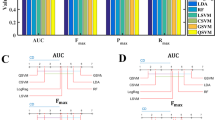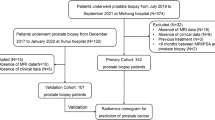Abstract
Radiomics can quantify tumor phenotypic characteristics non-invasively by defining a signature correlated with biological information. Thanks to algorithms derived from computer vision to extract features from images, and machine learning methods to mine data, Radiomics is the perfect case study of application of Artificial Intelligence in the context of precision medicine. In this study we investigated the association between radiomic features extracted from multi-parametric magnetic resonance imaging (mp-MRI)of prostate cancer (PCa) and the tumor histologic subtypes (using Gleason Score) using machine learning algorithms, in order to identify which of the mp-MRI derived radiomic features can distinguish high and low risk PCa.
Access this chapter
Tax calculation will be finalised at checkout
Purchases are for personal use only
Similar content being viewed by others
Notes
- 1.
The Gleason grading system is used to help evaluate the prognosis of men with prostate cancer using samples from a prostate biopsy. The pathologist looks at how the cancer cells are arranged in the prostate and assigns a score on a scale of 3 to 5 from 2 different locations. Please note the notation: the first number is the most common grade in all the samples, while the second number is the highest grade of what’s left. Gleason Score = the most common grade + the highest other grade in the samples.
- 2.
The PI-RADS v2 [25] (Prostate Imaging Reporting & Data System) assessment categories are based on the findings of mp-MRI, combining T2-weighted (T2W), diffusion weighted imaging (DWI) and dynamic contrast-enhanced (DCE) imaging. The PI-RADS assessment category determines the likelihood of clinically significant prostate cancer. A score, ranging from 1 to 5, is given accordingly to each imaging technique, with 1 being most probably benign (clinically significant cancer is highly unlikely to be present) and 5 being high suspicious for malignancy.
References
Lambin, P., et al.: Radiomics: the bridge between medical imaging and personalized medicine. Nat. Rev. Clin. Oncol. 14, 749 (2017). https://doi.org/10.1038/nrclinonc.2017.141
Gillies, R.J., Kinahan, P.E., Hricak, H.: Radiomics: images are more than pictures, they are data. Radiology 278(2), 563–577 (2016). https://doi.org/10.1148/radiol.2015151169
Larue, R.T.H.M., et al.: Influence of gray level discretization on radiomic feature stability for different CT scanners, tube currents and slice thiknesses: a comprehensive phantom study. Acta Oncol. 56, 1544–1553 (2017)
Barucci, A., et al.: Exposing cancer’s complexity using radiomics in clinical imaging. An investigation on the role of histogram analysis as imaging biomarker to unravel intra-tumour heterogeneity. In: 2018 IEEE Workshop on Complexity in Engineering (COMPENG), pp. 1–5 (2018). https://doi.org/10.1109/CompEng.2018.8536244
Stoyanova, R., et al.: Prostate cancer radiomics and the promise of radiogenomics. Transl. Cancer Res. 5(4), 432–447 (2016). https://doi.org/10.21037/tcr.2016.06.20
Aerts, H.J., Velazquez, E.R., Leijenaar, R.T., Parmar, C., Grossmann, P., Carvalho, S., et al.: Decoding tumour phenotype by noninvasive imaging using a quantitative radiomics approach. Nat. Commun. 5, 4006 (2014). https://doi.org/10.1038/ncomms5006
Avanzo, M., Stancanello, J., El Naga, I.: Beyond imaging: the promise of radiomics. Physica Med. 38, 122–139 (2017). https://doi.org/10.1016/j.ejmp.2017.05.071
Bray, F., et al.: Global cancer statistics 2018: GLOBOCAN estimates of incidence and mortality worldwide for 36 cancers in 185 countries. CA Cancer J. Clin. 68, 394–424 (2018)
Ahmed, H.U., et al.: Transatlantic consensus group on active surveillance and focal therapy for prostate cancer. BJU Int. 109, 1636–1647 (2012)
King, C.R., Long, J.P.: Prostate biopsy grading errors: a sampling problem? Int. J. Cancer 90, 326–330 (2000)
Epstein, J.I., Feng, Z., Trock, B.J., Pierorazio, P.M.: Upgrading and downgrading of prostate cancer from biopsy to radical prostatectomy: incidence and predictive factors using the modified Gleason grading system and factoring in tertiary grades. Eur. Urol. 61, 1019–1024 (2012)
Berglung, R.K., et al.: Pathological upgrading and up staging with immediate repeat biopsy in patients elegible for active surveillance. J. Urol. 180, 1964–1967 (2008)
Peng, Y., et al.: Quantitative analysis of multiparametric prostate MR images: differentiation between prostate cancer and normal tissue and correlation with Gleason score-a computer-aided diagnosis development study. Radiology 267, 787–796 (2013)
Tiwari, P., Viswanath, S., Kurhanewicz, J., Sridhar, A., Madabhushi, A.: Multimodal wavelet embedding representation for data combination (MaWERiC): integrating magnetic resonance imaging and spectroscopy for prostate cancer detection. NMR Biomed. 25, 607–619 (2012)
Moradi, M., et al.: Multiparametric MRI maps for detection and grading of dominant prostate tumors. J. Magn. Reson. Imaging 35, 1403–1413 (2012)
Barucci, A., et al.: 301. Prostate cancer Radiomics using multiparametric MR imaging: an exploratory study. In: Proceedings of 10th Congress of the Associazione Italiana di Fisica Medica - AIFM. Physica Medica: Eur. J. Med. Phys. 56, 246. Elsevier (2018). https://doi.org/10.1016/j.ejmp.2018.04.310
Mazaheri, Y., et al.: Prostate cancer: identification with combined diffusion weighted MR imaging and 3D 1H MR spectroscopic imaging-correlation with pathologic findings. Radiology 246, 480–488 (2008)
Wibmer, A., et al.: Haralick texture analysis of prostate MRI: Utility for differentiating non-cancerous prostate from prostate cancer and differentiating prostate cancers with different Gleason scores. Eur. Radiol. 25, 2840–2850 (2015)
Fehr, D., et al.: Automatic classification of prostate cancer Gleason scores from multiparametric magnetic resonance images. Proc. Natl. Acad. Sci. USA 112, 6265–6273 (2015)
Chen, T., et al.: Prostate cancer differentiation and aggressiveness: assessment with a radiomic-based model vs. PI-RADS v2. J. Magn. Reson. Imaging 49, 875–884 (2019). https://doi.org/10.1002/jmri.26243
Sidhu, H.S., et al.: Textural analysis of multiparametric MRI detects transition zone prostate cancer. Eur. Radiol. 27, 1–11 (2017)
Khalvati, F., Wong, A., Haider, M.A.: Automated prostate cancer detection via comprehensive multi-parametric magnetic resonance imaging texture feature model. BMC Med. Imaging 15, 27 (2015)
Vignati, A., et al.: Texture features on T2-weighted magnetic resonance imaging: new potential biomarkers for prostate cancer aggressiveness. Phys. Med. Biol. 60, 2685–2701 (2015)
Nketiah, G., et al.: T2-weighted MRI-derived textural features reflect prostate cancer aggressiveness: preliminary results. Eur. Radiol. 27, 3050–3059 (2016)
Weinreb, J.C., et al.: PI-RADS prostate imaging - reporting and data systems: 2015, version 2. Eur. Urol. 69, 16–40 (2016)
Langer, D.L., et al.: Prostate tissue composition and MR measurements: investigating the relationships between ADC, T2, K(trans), v(e), and corresponding histologic features. Radiology 255, 485–494 (2010)
Oto, A., et al.: Diffusion-weighted and dynamic contrast-enhanced MRI of prostate cancer: correlation of quantitative MR parameters with Gleason score and tumor angiogenesis. AJR Am. J. Roentgenol. 197, 1382–1390 (2011)
Nagarajan, M.B., et al.: Classification of small lesions in breast MRI: evaluating the role of dynamically extracted texture features through feature selection. J. Med. Biol. Eng. 33, 33 (2013)
Fedorov, A., et al.: 3D slicer as an image computing platform for the quantitative imaging network. Magn. Reson. Imaging 30(9), 1323–1341 (2012)
van Griethuysen, J.J.M., et al.: Computational radiomics system to decode the radiographic phenotype. Cancer Res. 77(21), e104–e107 (2017)
Author information
Authors and Affiliations
Corresponding author
Editor information
Editors and Affiliations
Rights and permissions
Copyright information
© 2019 Springer Nature Switzerland AG
About this paper
Cite this paper
Germanese, D. et al. (2019). May Radiomic Data Predict Prostate Cancer Aggressiveness?. In: Vento, M., et al. Computer Analysis of Images and Patterns. CAIP 2019. Communications in Computer and Information Science, vol 1089. Springer, Cham. https://doi.org/10.1007/978-3-030-29930-9_7
Download citation
DOI: https://doi.org/10.1007/978-3-030-29930-9_7
Published:
Publisher Name: Springer, Cham
Print ISBN: 978-3-030-29929-3
Online ISBN: 978-3-030-29930-9
eBook Packages: Computer ScienceComputer Science (R0)




